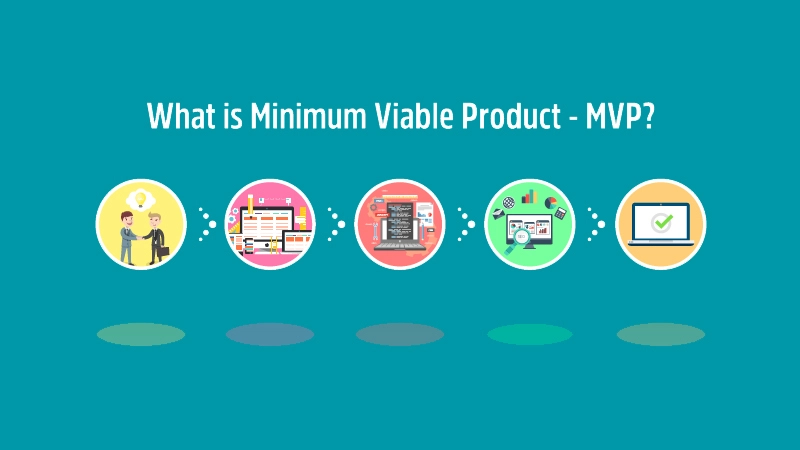Case study
Are you looking for a cost-effective way to test your product idea? You may want to consider a minimum viable product (MVP). MVP helps you get a jumpstart on product development with minimal resources. It is an opportunity to gather early user feedback, validate assumptions, and make informed decisions about feature prioritization. Our blog post discusses the value, limitations, and development stages of MVP.
In the modern market, new startups are created all the time. However, statistics show that they fail much more often than they succeed. Of course, it’s not a reason not to bring your idea to life. One of the ways to make a successful startup is to build a minimum viable product (MVP) before releasing a full-featured solution. So, what is MVP, how to create it, and is it worth the effort? Let’s find out.
A concept of MVP
The concept of MVP is very popular in today’s IT industry and software market. To create a
startup, you need to go through many stages: coming up with a business idea, planning how to
put it into practice, implementing it, and waiting for the results. The process is quite
complicated, long, costly, and time-consuming. But the hardest part here is defining whether
your target audience really needs your product. Because, eventually, all the products are
made for the users, and if there is no one who is ready to buy a product– a startup fails.
To get more predictable results and to understand what exactly your customers need without spending
too much effort and money, you can
build an MVP first. A minimum
viable product is a rapidly built version of a product that includes only the core features.
It’s made for getting enough information about the product: how it’s used by potential users
and what can be improved to make this product successful. In general, MVP development saves time
and costs, lets you get feedback from end-users and test your assumptions.

Minimum viable product development was promoted by Eric Ries, an entrepreneur in Silicon
Valley, within the lean startup methodology. Ries states that there is no point in
developing a full-featured product when you can build an MVP first and add more features
after testing it. An MVP stage makes the product launch much less risky.
You can build your MVP as a mobile app or as a part of it, a website, a landing page, or even
a simple wireframe. The most important part here is that its limited set of new features should
deliver the right product idea to customers and show them the real product value.
Pros & cons of MVP approach
Building an MVP has many advantages. Let’s discuss the most important of them:
Testing a product
An MVP allows you to show users the primary version of your product and get market validation. Although you don’t have a complete and final version of a product at the MVP development stage, learning what the customers think about it will help you understand what you have to change and improve, which features are necessary and which are not, and whether a future product meets market needs at all.
Saving costs
You never know whether your project will be successful or fail. Releasing a final product and discovering that it needs considerable changes at the last stage of product development will cost you a lot of money. Meanwhile, if you build an MVP, it will give you a chance to measure the efficiency of your product early on. In other words, if your business idea doesn’t work, launching MVP will be less costly compared to launching the full-featured version of the product.
Winning the market faster
When you build an MVP, you get an imperfect version of your product with only key features, so, naturally, it will not capture all your potential customers, just early adopters. But creating an MVP gives you an opportunity to assess your potential market share and attract your first customers, which will help you win the market faster.
A better final product
Building an MVP will help you understand customer needs better and the way people want to
use your product. By keeping this in mind, your
outsourced development team will be able to
create a user flow specifically tailored to user expectations and, as a result, develop a
product that people will want to buy.
But there are also some challenges of MVP development. Let’s talk about them, too.
Determining a minimum set of core features may be tricky
MVP must contain a limited number of features that are just enough to get user feedback and validate key assumptions. But, sometimes, it is hard to decide what features have to be included in this “minimum set.” In most cases, this task requires comprehensive market research and competitor analysis.
Limitations in some business sectors
There are some industries with strict regulations or other limitations, so launching a minimum viable product on these markets can be challenging. For example, when it comes to projects in medicine, all products (including MVPs) must comply with industry laws and standards (like HIPAA in the US). If it’s the case, you have to build not only a decent user experience and a minimum set of features but also consider all technical aspects required by law. This might complicate the MVP development process.
Extra effort and dedication
The process of building a minimum viable product requires extra effort and specific expertise. To gather all the feedback and apply this knowledge in practice, a product development team needs to have enough time and skills.
Types of MVP
MVPs can come in different forms. The most common types of minimum viable product are the following:
Wireframe
Creating a wireframe does not require a lot of cost and time, so it’s the most affordable type of minimum viable product. There are no designs and colors here, just a roughly built scheme of screen layouts, navigation system, and the core features of a future product. Wireframes are made to demonstrate a user flow, the main purpose of the product, and its functions. They usually do not look very attractive or realistic, but they allow people to visualize a product by delivering the right message to them.
Mockup
Mockups are like wireframes but more alive. They look more realistic and resemble your final product to a greater extent. The features, navigation, design, and even colors reflect the future product. You can also build an interactive mockup to show your app features in action. Creating a mockup is a great way to define the user flow and improve it before the first line of code is even written.
Explainer video

If you feel that it is too complicated to actually build an MVP to show the target audience
the product features and user flow, you can just create a video. It may look way too simple,
but there are cases when explainer videos paved the way to success.
For instance, the product development of Dropbox was supposed to be big and costly. So, instead
of putting a great deal of time, effort, and money into it without being sure how it will end,
the Dropbox team made a short explainer video for the investors, showing the main idea of the
project, its key features, and advantages. As a result, Dropbox was more than just seen; it got
funding and proved that visualization is powerful when used properly.
If you share your video on social media, chances are you’ll get first adopters of a product before
the development team even starts working on it.
Landing page
Creating a landing page is also a great idea if you want to build a successful product. It is a relatively simple and pretty cheap way to get user feedback about your idea. With a landing page you can present your project to the public, emphasizing its key elements and benefits and attracting your first customers. It is an affordable way to demonstrate your product, get users’ feedback, and attract investors.
Prototype
Prototypes are supposed to show the feasibility of the projects. It is a rapidly built version of a product with only basic features and functions. It takes some time and money to create a prototype, but it can bring many valuable results. In comparison with the other options we mentioned, a prototype is the most realistic type of an MVP. Prototypes allow users to experience the product, so the team can gather valuable user feedback.
MVP development stages
The overall process of creating a successful MVP consists of several stages. Let’s take a closer look at each of them.
Defining the problem
MVP as well as your final product has to provide a solution to a problem you want to solve. There must be some goal for your project, the reason why you want to create a product, as well as its ability to be useful for customers.
Defining the target market
You have to know your target audience, who your customers are, and how many people would potentially want to use your product.
Formulating a hypothesis
When you build an MVP, you need to have some assumptions of how it will provide a solution to user problems, how your customers will interact with a product, and what exactly you want to reach by creating a product.
Creating a list of features and defining the most important
You should think of the features you want to include in your minimum viable product to show future customers its value and benefits.

Developing MVP
To build an MVP, you need to gather a team of professional developers who can help to deal with this task. It’s important to make your product right, so you can validate the hypothesis you formulated above.
Launching a product
Demonstrating your MVP to the market and allowing users to test it is the next logical stage of MVP development.
Gathering user feedback and its analyzing it
It is important to learn as much as you can from MVP development to figure out whether your product solves a problem and meets customer needs.
Iterating again
Product development is a continuous process that usually requires multiple iterations of all the stages we mentioned above.
How much MVP development costs
Not that you know how to build an MVP, let’s discuss how much it can cost you. Since there
are multiple ways to build it and different project requirements, there is no single answer
to this question. But here are the factors that may affect the cost of your MVP development:
Platform. Choosing mobile, web, desktop, or any other platform will
definitely have an impact on the costs you spend on your product. At the MVP stage, it is
better to focus on one platform to give your project a try and see how customers react to
it.

Features and functionalities. You can create a simple wireframe or an
interactive prototype with more features and functionalities.
An online payment system. If you want to collect some funds at this stage,
adding an online payment system to your MVP will take extra costs.
Design. The design makes your product visually attractive and desirable.
However, building it takes some costs. Creating a beautiful custom design is definitely an
expensive whim, so you can wait with it till it’s time to make your final product.
Meanwhile, using some basic and standard design will allow you to minimize the costs at this
early stage.
The way of developing. Finally, you can always choose the way your MVP
will be created and how the process will be organized. You can do it on your own, hire
freelancers, outsource the services, or just cooperate with a software development agency.
So, summing up, the amount of money you’ll need to create an MVP depends on many factors, so
you should ask your development team for a more detailed estimation.
How to build an MVP
There are several approaches to MVP development — all of them have their advantages and disadvantages.
Developing MVP on your own
If you feel confident about doing it and have enough skills and resources, you can build an MVP on your own. For instance, if you want to start with a landing page, you can use free website builders. Of course, all the development, management, technical, and organizational details will be on you, but you can save a lot of money. However, involving a CTO early on can provide essential technical guidance, even if you're building the MVP independently.
Hiring freelancers

In most cases, the most optimal solution is to hire a team of developers who know how to make a successful MVP. In this case, the costs will depend on the country you choose for hiring a team and whether you hire people on a project basis or based on hourly rates. This approach has its pros and cons. On the one hand, it is costly and takes time to hire the right people. On the other hand, qualified specialists can help you get the right results.
Hiring a software development agency
This option is probably the most expensive one, but it’s also the most reliable. Hiring a software development company allows you to receive all services needed for the full development of your product. Your ideas and vision can be clearly passed to developers with the help of project managers. You will have a dedicated team for your project, testing, designing, UX, and project management.
Conclusions
No matter how brilliant your idea is, you never know whether it will work or not unless you test it with users. Creating a full-featured product is not only expensive and time-consuming, but it’s also risky. That’s why the idea of creating a minimum viable product looks like a wise decision if you want to build a product customers will love. There are a lot of ways of doing it, and it is up to you which one to choose.
